Synthesis and Evaluation of Poly(hexamethylene-urethane) and PEG-Poly(hexamethylene-urethane) and Their Cholesteryl Oleyl Carbonate Composites for Human Blood Biocompatibility
Abstract
:1. Introduction
2. Results and Discussion
2.1. Results
2.1.1. Characterization of UAA and PEG-UAA
2.1.2. Observation of Surface Morphology and Platelet Adhesion on the Polymers Hexamethylene PU and PEG-Hexamethylene PU and Their COC Composites
2.1.3. Contact Angle Measurements of Polymers and Polymer-COC Composites
2.1.4. Functional Assay for Evaluation of Platelet Activation: P-Selectin Measurements
2.1.5. Blood Clotting Properties of Hexamethylene PU and PEG-Hexamethylene PU and Their COC Composites
2.1.6. The Hemolysis Properties of the Polymers and Polymer-COC Composites
2.2. Discussion
3. Experimental Section
3.1. General
3.2. Synthesis of UAA and PEG-UAA as Polymer-Blocks
3.3. Preparation of Polymers and Polymer-Liquid Crystal Composites via Photo-Polymerization
3.4. Tensile Strength Analysis and Contact Angle Measurements of Polymers and Polymer-COC Composites
3.5. Observation of Platelet Adhesion by SEM and Evaluation of Platelet Activation (Coope’s Classification)
3.6. Evaluation of Platelet Activation by P-Selectin Measurements
3.7. In Vitro Blood Compatibility Test: Blood Clotting Measurements
3.8. In Vitro Blood Compatibility Test: Hemolysis Ratio Measurements
3.9. Statistical Analysis
4. Conclusions
Conflict of Interest
References
- Ravi, S.; Qu, Z.; Chaikof, E.L. Polymeric materials for tissue engineering of arterial substitutes. Vascular 2009, 17, S45–S54. [Google Scholar] [CrossRef] [PubMed]
- Sahithi, K.; Swetha, M.; Ramasamy, K.; Srinivasan, N.; Selvamurugan, N. Polymeric composites containing carbon nanotubes for bone tissue engineering. Int. J. Biol. Macromol. 2010, 46, 281–283. [Google Scholar] [CrossRef] [PubMed]
- Rosellini, E.; Cristallini, C.; Barbani, N.; Vozzi, G.; D’Acunto, M.; Ciardelli, G.; Giusti, P. New bioartificial systems and biodegradable synthetic polymers for cardiac tissue engineering: A preliminary screening. Biomed. Eng.-Appl. Basis Commun. 2010, 22, 497–507. [Google Scholar] [CrossRef]
- Guo, J.; Feng, Y.; Ye, Y.; Zhao, H. Construction of hemocompatible polycarbonate urethane with sulfoammonium zwitterionic polyethylene glycol. J. Appl. Polym. Sci. 2011, 122, 1084–1091. [Google Scholar] [CrossRef]
- Wang, Y.; Xu, W.; Chen, Y. Surface modification on polyurethanes by using bioactive carboxymethylated fungal glucan from Poria cocos. Colloid Surf. B-Bisointerfaces 2010, 81, 629–633. [Google Scholar] [CrossRef] [PubMed]
- Shih, M.F.; Shau, M.D.; Chang, M.Y.; Chiou, S.K.; Chang, J.K.; Cherng, J.Y. Platelet adsorption and hemolytic properties of liquid crystal/composite polymers. Int. J. Pharm. 2006, 327, 117–125. [Google Scholar] [CrossRef] [PubMed]
- Grunkemeier, J.M.; Tsai, W.B.; Horbett, T.A. Hemocompatibility of treated polystyrene substrates: contact activation, platelet adhesion, and procoagulant activity of adherent platelets. J. Biomed. Mater. Res. 1998, 41, 657–670. [Google Scholar] [CrossRef]
- Rangwala, H.S.; Ionita, C.N.; Rudin, S.; Baier, R.E. Partially polyurethane-covered stent for cerebral aneurysm treatment. J. Biomed. Mater. Res. Part B 2009, 89, 415–429. [Google Scholar] [CrossRef] [PubMed]
- McBane, J.E.; Sharifpoor, S.; Cai, K.; Labow, R.S.; Santerre, J.P. Biodegradation and in vivo biocompatibility of a degradable, polar/hydrophobic/ionic polyurethane for tissue engineering applications. Biomaterials 2011, 32, 6034–6044. [Google Scholar] [CrossRef] [PubMed]
- Blit, P.H.; McClung, W.G.; Brash, J.L.; Woodhouse, K.A.; Santerre, J.P. Platelet inhibition and endothelial cell adhesion on elastin-like polypeptide surface modified materials. Biomaterials 2011, 32, 5790–5800. [Google Scholar] [CrossRef] [PubMed]
- Lin, S.Y.; Ho, C.J.; Li, M.J. Precision and reproducibility of temperature response of a thermo-responsive membrane embedded by binary liquid crystals for drug delivery. J. Control. Release 2001, 73, 293–301. [Google Scholar] [CrossRef]
- Rao, H.; Zhang, Z.; Song, C.; Qiao, T. Polydimethylsiloxane/liquid crystal cross-linked membranes: Preparation, characterization and oxygen transport properties. React. Funct. Polym. 2011, 71, 537–543. [Google Scholar] [CrossRef]
- Makai, M.; Csanyi, E.; Nemeth, Z.; Palinkas, J.; Eros, I. Structure and drug release of lamellar liquid crystals containing glycerol. Int. J. Pharm. 2003, 256, 95–107. [Google Scholar] [CrossRef]
- Tu, L.; Li, M.; Mou, S.; Zhou, C. Preparation and blood compatibility of polysiloxane/liquid-crystal composite membranes. Biomaterials 2001, 22, 2595–2599. [Google Scholar]
- Lin, S.Y.; Lin, H.L.; Li, M.J. Manufacturing factors affecting the drug delivery function of thermo-responsive membrane prepared by adsorption of binary liquid crystals. Eur. J. Pharm. Sci. 2002, 17, 153–160. [Google Scholar] [CrossRef]
- Tao, W.; Zhou, H.; Zhang, Y.; Li, G. Novel silsesquioxane mixture-modified high elongation polyurethane with reduced platelet adhesion. Appl. Surf. Sci. 2008, 254, 2831–2836. [Google Scholar] [CrossRef]
- McEver, R.P.; Beckstead, J.H.; Moore, K.L.; Marshall-Carlson, L.; Bainton, D.F. GMP-140, a platelet alpha granule protein, is also synthesized by vascular endothelium and is located in Weibel-Palade bosies. Clin. Invest. 1989, 84, 92–99. [Google Scholar] [CrossRef] [PubMed]
- Rand, M.L.; Leung, R.; Packham, M.A. Platelet function assays. Transfus. Apher. Sci. 2003, 28, 307–317. [Google Scholar] [CrossRef]
- Pan, J.; Li, G.; Chen, Z.; Chen, X.; Zhu, W.; Xu, K. Alternative block polyurethanes based on poly(3-hydroxybutyrate-co-4-hydroxybutyrate) and poly(ethylene glycol). Biomaterials 2009, 30, 2975–2984. [Google Scholar] [CrossRef] [PubMed]
- Zhou, C.; Yi, Z. Blood-compatibility of polyurethane/liquid crystal composite membranes. Biomaterials 1999, 20, 2093–2099. [Google Scholar] [CrossRef]
- Dalsin, J.L.; Hu, B.H.; Lee, B.P.; Messersmith, P.B. Mussel adhesive protein mimetic polymers for the preparation of nonfouling surfaces. J. Am. Chem. Soc. 2003, 125, 4253–4258. [Google Scholar] [CrossRef] [PubMed]
- Knop, K.; Hoogenboom, R.; Fischer, D.; Schubert, U.S. Poly(ethylene glycol) in drug delivery: Pros and Cons as well as potential alternatives. Angew. Chem. Int. Ed. 2010, 49, 6288–6308. [Google Scholar] [CrossRef] [PubMed]
- Zang, J.; Yuan, J.; Yuan, Y.; Zang, X.; Shen, J.; Lin, S. Platelet adhesive resistance of segmented polyurethane film surface-grafted with vinyl benzyl sulfo monomer of ammonium zwitterions. Biomaterials 2003, 24, 4223–4231. [Google Scholar] [CrossRef]
- Yuan, J.; Chen, L.; Jiang, X.; Shen, J.; Lin, S. Chemical graft polymerization of sulfobetaine monomer on polyurethane surface for reduction in platelet adhesion. Colloid Surf. B-Biointerfaces 2004, 39, 87–94. [Google Scholar] [CrossRef] [PubMed]
- Poussard, L.; Burel, F.; Couvercelle, J.P.; Lesouhaitier, O.; Merhi, Y.; Tabrizian, M.; Bunel, C. In vitro thrombogenicity investigation of new water-dispensible polyurethane anionomers bearing carboxylate groups. J. Biomater. Sci.-Polym. Ed. 2005, 16, 335–351. [Google Scholar] [CrossRef] [PubMed]
- Yuan, J.; Hou, Q.; Liu, B.; Shen, J.; Lin, S. Platelet adhesive resistance of polyurethane surface grafted with zwitterions of sulfobetaine. Colloid Surf. B-Biointerfaces 2004, 36, 19–26. [Google Scholar]
- Xu, L.C.; Runt, J.; Siedlecki, C.A. Dynamics of hydrated polyurethane biomaterials: Surface microphase restructuring, protein activity and platelet adhesion. Acta Biomater. 2010, 6, 1938–1947. [Google Scholar] [CrossRef] [PubMed]
- Dimitrievska, S.; Maire, M.; Diaz-Quijada, G.A.; Robitaille, L.; Ajji, A.; Yahia, L.; Moreno, M.; Merhi, Y.; Bureau, M.N. Low thrombogenicity coating of nonwoven PET fiber structures for vascular grafts. Macromol. Biosci. 2011, 11, 493–502. [Google Scholar] [CrossRef] [PubMed]
- Morimoto, N.; Iwasaki, Y.; Nakabayashi, N.; Ishihara, K. Physical properties and blood compatibility of surface-modified segmented polyurethane by semi-interpenetrating polymer networks with a phospholipid polymer. Biomaterials 2002, 23, 4881–4887. [Google Scholar] [CrossRef]
- Nakabayashi, N.; Williams, D.F. Preparation of non-thrombogenic materials using 2-methacryloyloxyethyl phosphorylcholine. Biomaterials 2003, 24, 2431–2435. [Google Scholar] [CrossRef]
- Korematsu, A.; Yakemoto, Y.; Nakaya, T.; Inoue, H. Synthesis, characterization and platelet adhesion of segmented polyurethanes grafted phospholipid analogous vinyl monomer on surface. Biomaterials 2002, 23, 263–271. [Google Scholar] [CrossRef]
- Gorbet, M.B.; Sefton, M.V. Biomaterial-associated thrombosis: Roles of coagulation factors, complement, platelets and leukocytes. Biomaterials 2004, 25, 5681–5703. [Google Scholar] [CrossRef] [PubMed]
- Spijker, H.T.; Busscher, H.J.; van Oeveren, W. Influence of abciximab on the adhesion of platelets on a shielded plasma gradient prepared on polyethylene. Thromb. Res. 2002, 108, 57–62. [Google Scholar] [CrossRef]
Sample Availability: Not available. |
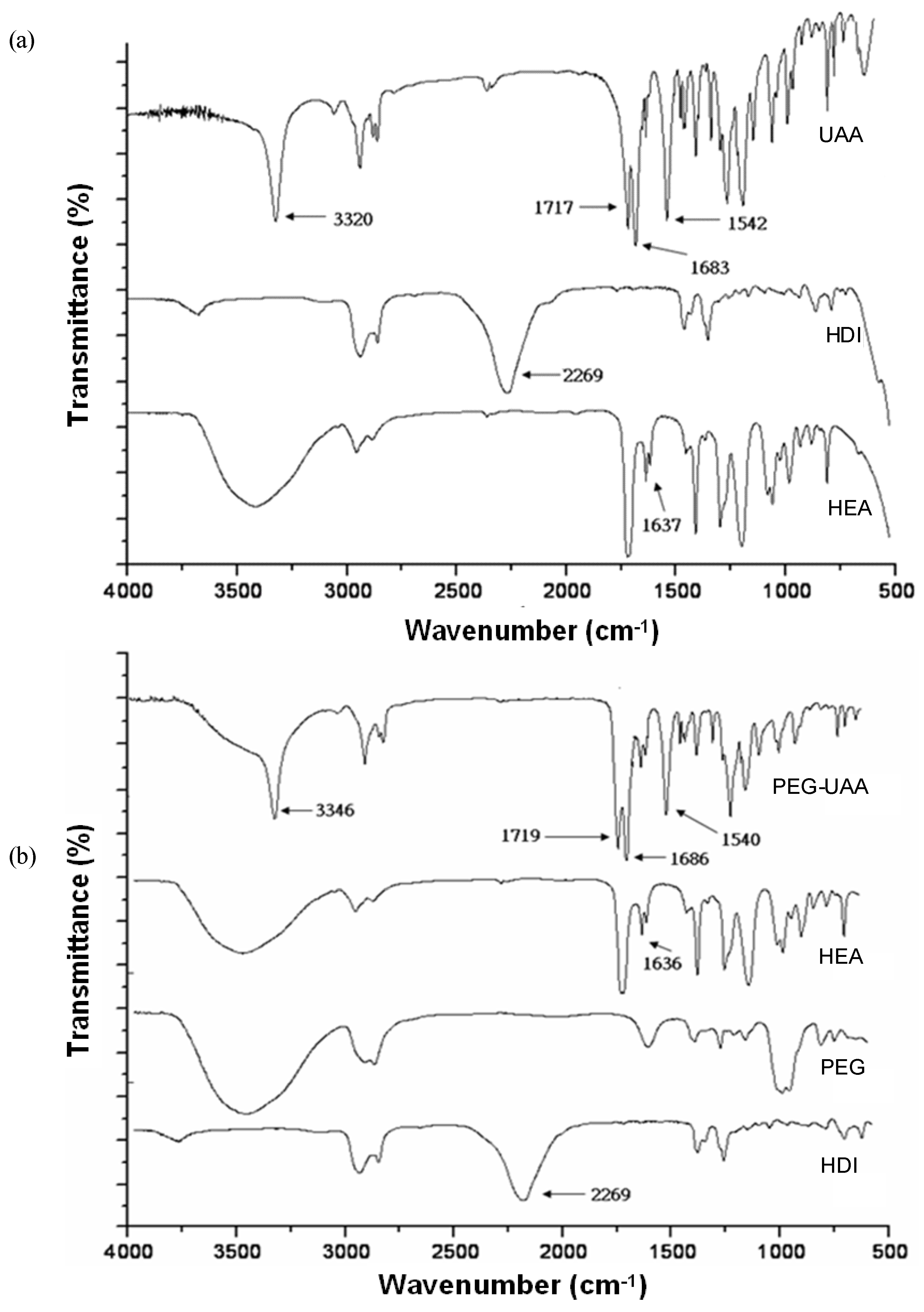
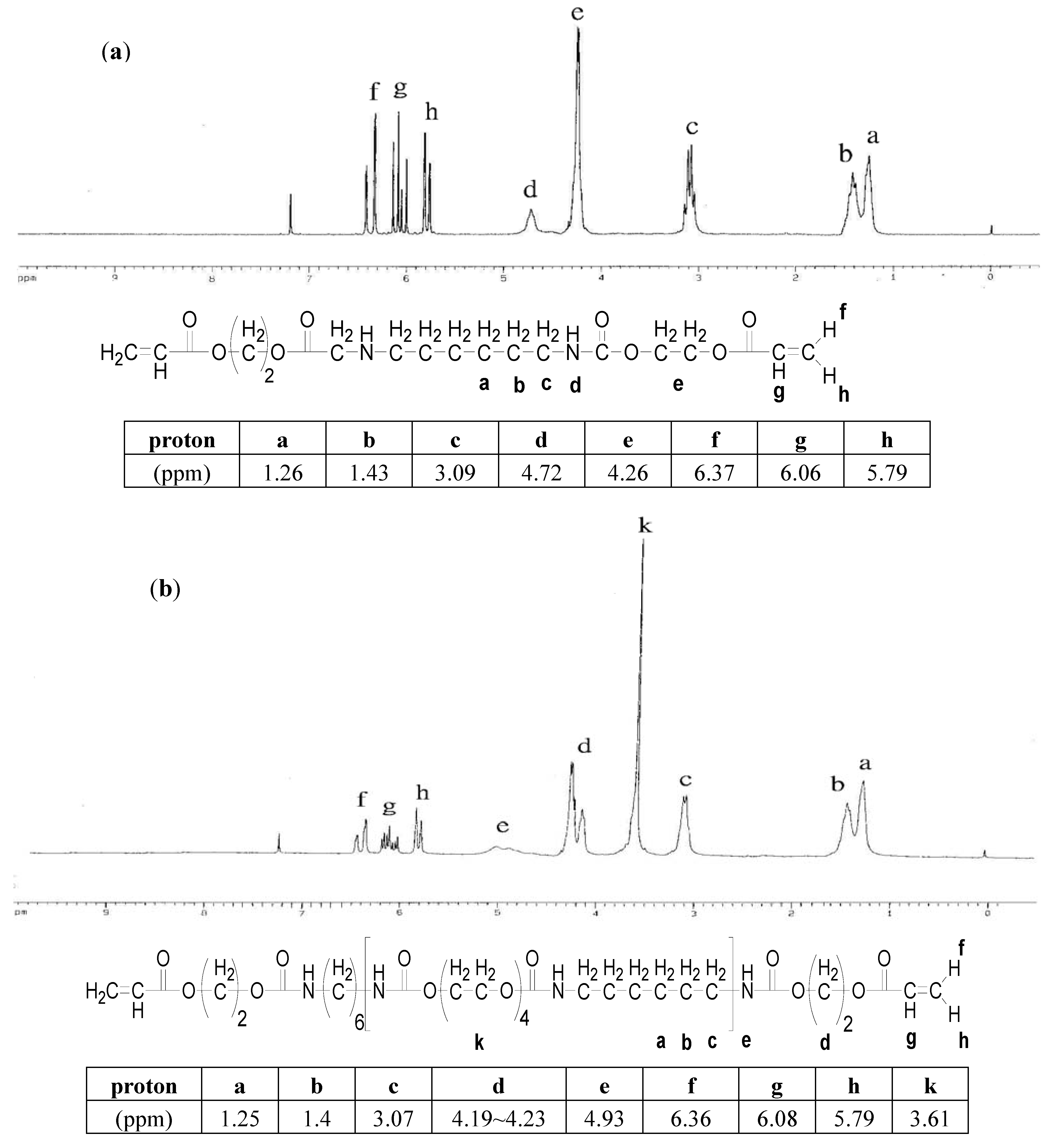

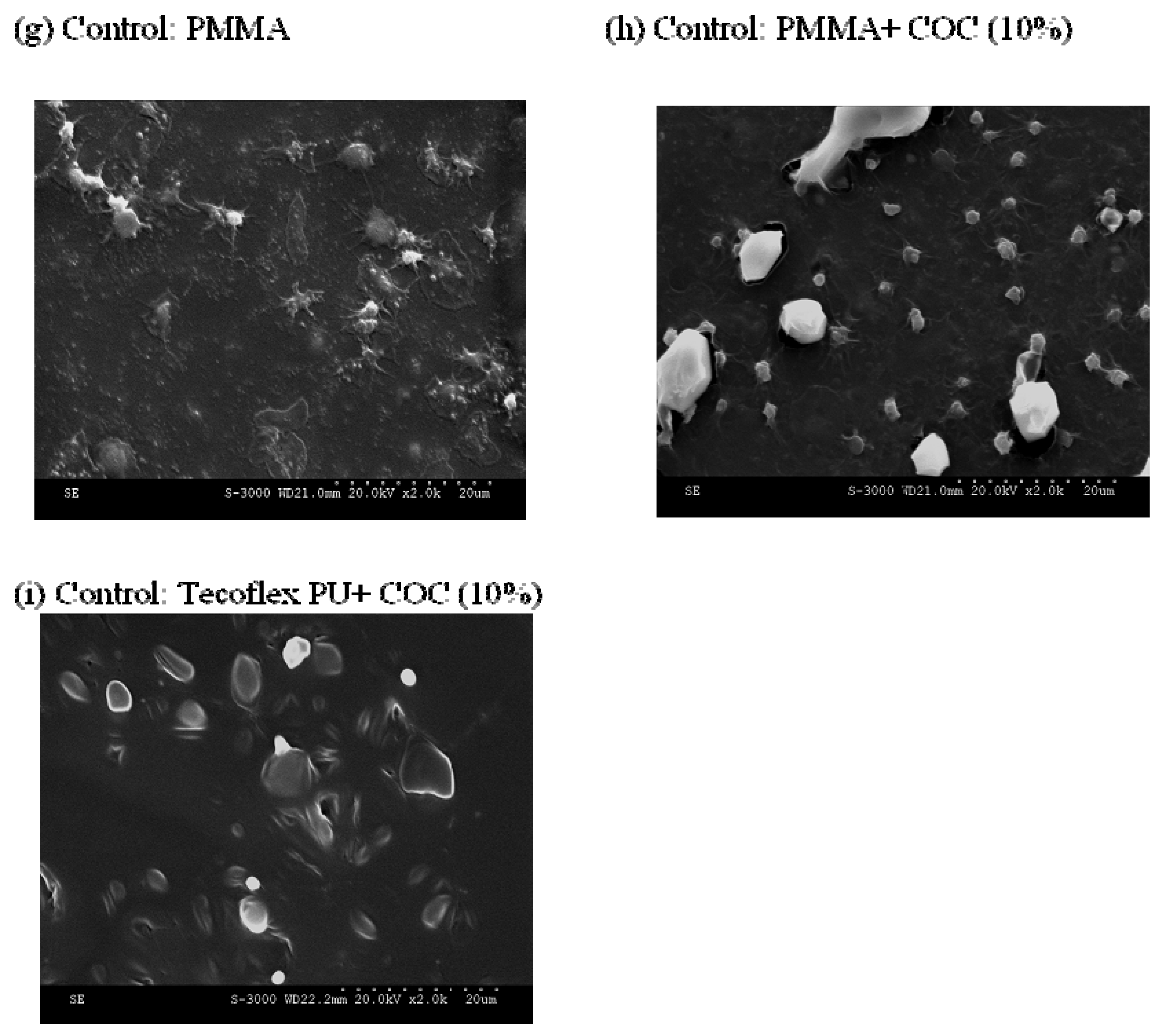


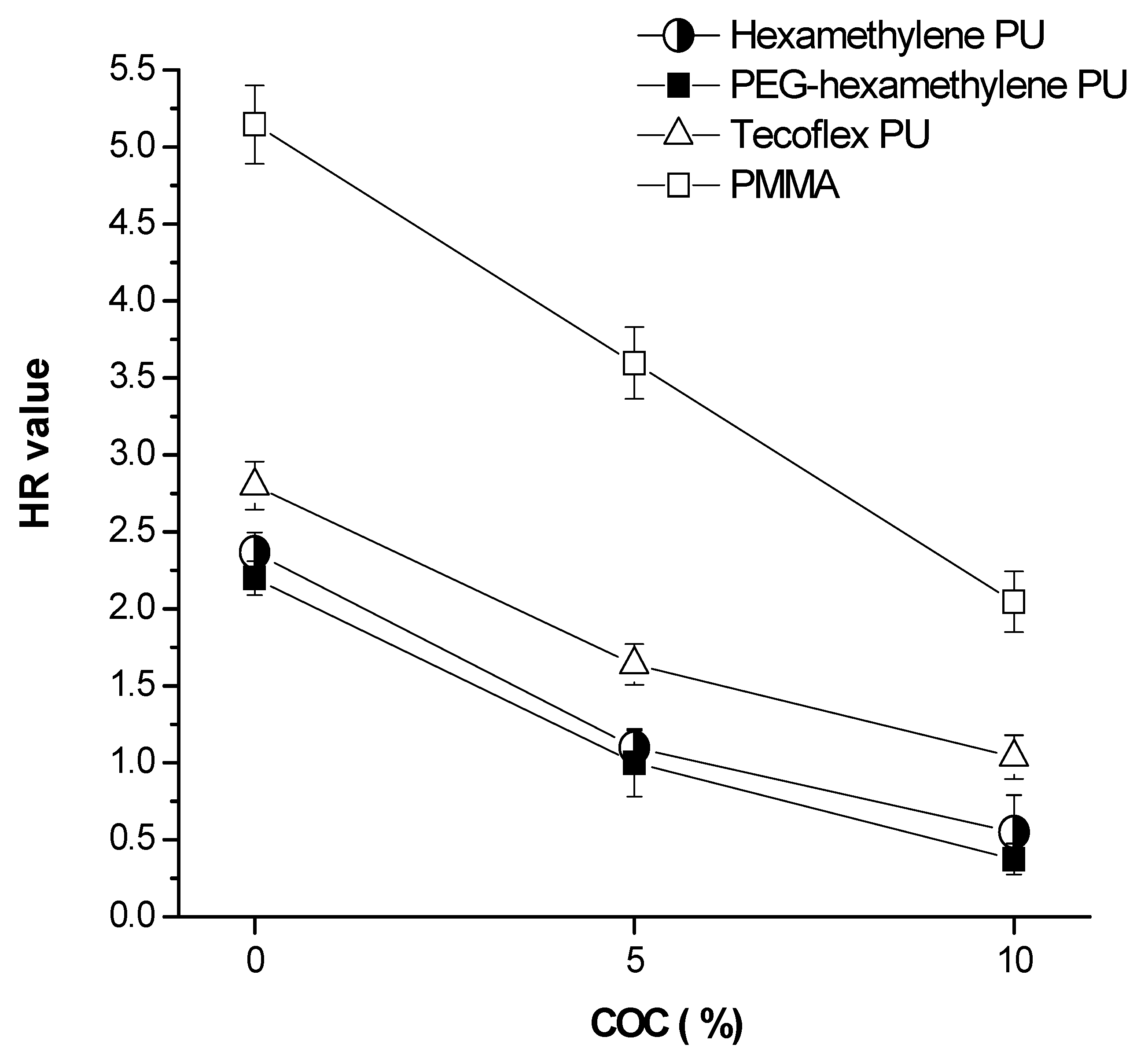
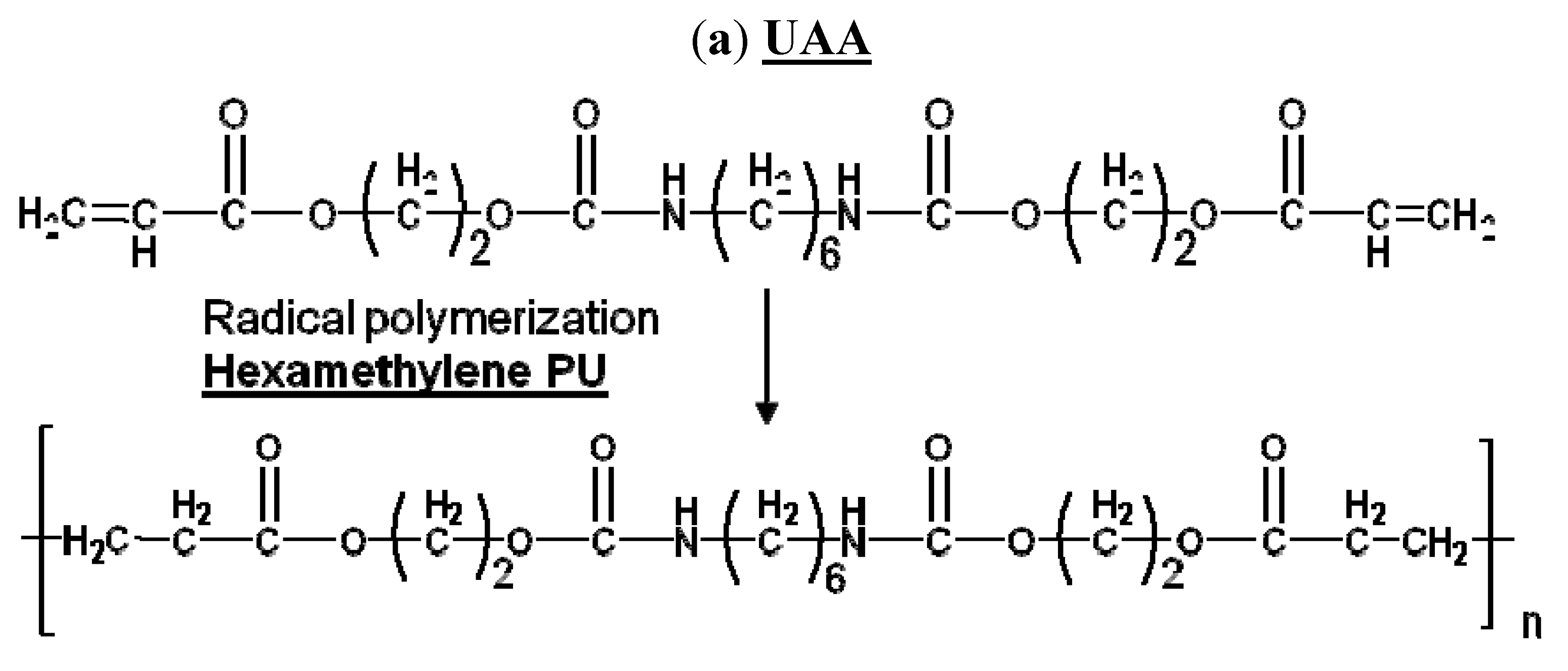

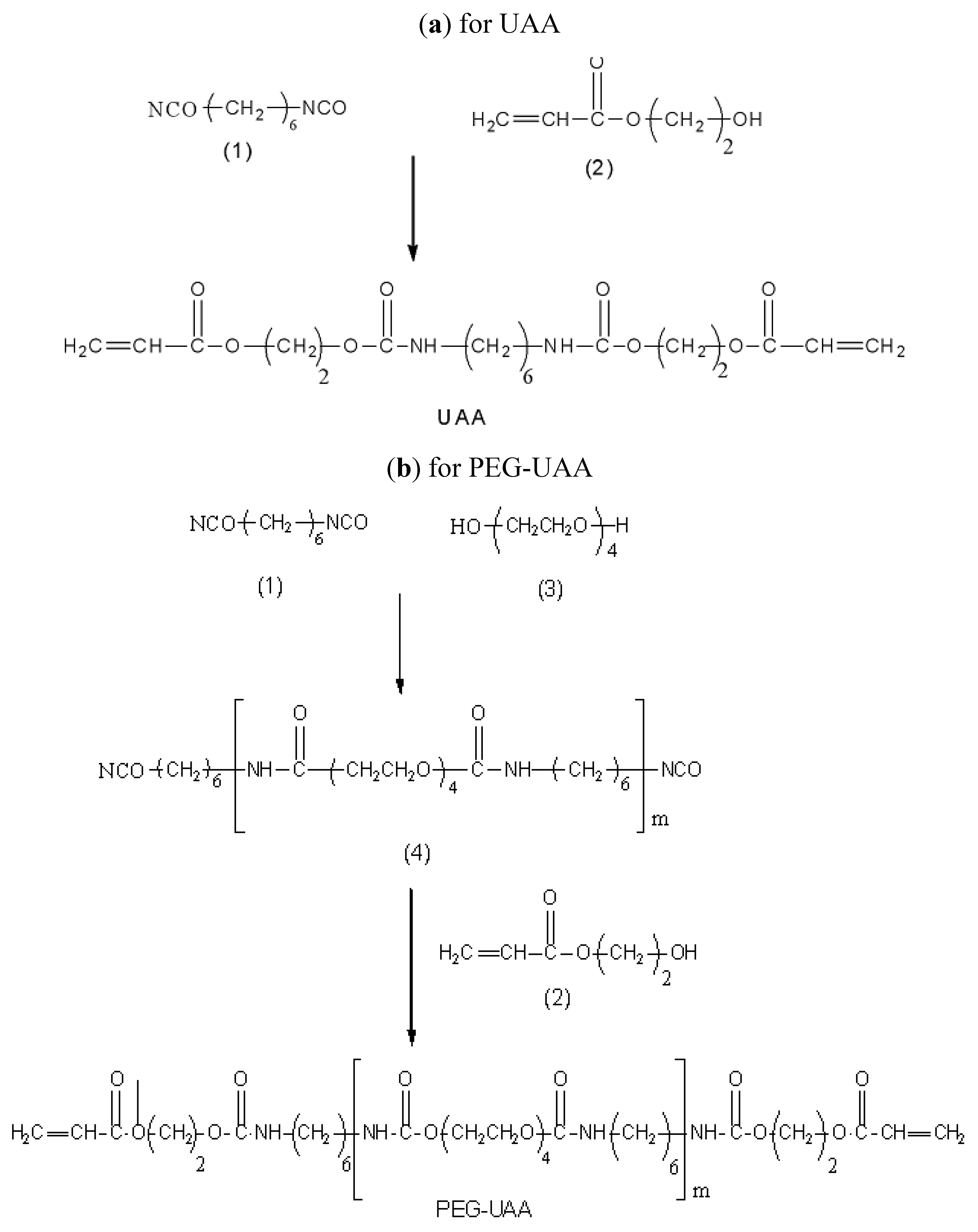
| Contact angle (degree) | PMMA | Tecoflex PU | Hexamethylene PU | PEG-hexamethylene PU |
|---|---|---|---|---|
| Polymer | 95 ± 0.5 | 89 ± 0.3 | 79 ± 0.4 | 69 ± 0.4 |
| Polymer + 10% COC | 80 ± 0.8 | 84 ± 1.1 | 70 ± 0.9 | 58 ± 0.6 |
| Stage | Description |
|---|---|
| I | Rounded platelets with no pseudopodia |
| II | Dendritic, rounded platelets with early pseudopodial formation |
| III | Spreading, dendritic platelets |
| IV | Spreading platelets and their hyaloplasm with prominent pseudopodial formation |
| V | Fully spread platelets over the entire surface |
© 2011 by the authors; licensee MDPI, Basel, Switzerland. This article is an open access article distributed under the terms and conditions of the Creative Commons Attribution license (http://creativecommons.org/licenses/by/3.0/).
Share and Cite
Shih, M.F.; Shau, M.D.; Hsieh, C.C.; Cherng, J.Y. Synthesis and Evaluation of Poly(hexamethylene-urethane) and PEG-Poly(hexamethylene-urethane) and Their Cholesteryl Oleyl Carbonate Composites for Human Blood Biocompatibility. Molecules 2011, 16, 8181-8197. https://doi.org/10.3390/molecules16108181
Shih MF, Shau MD, Hsieh CC, Cherng JY. Synthesis and Evaluation of Poly(hexamethylene-urethane) and PEG-Poly(hexamethylene-urethane) and Their Cholesteryl Oleyl Carbonate Composites for Human Blood Biocompatibility. Molecules. 2011; 16(10):8181-8197. https://doi.org/10.3390/molecules16108181
Chicago/Turabian StyleShih, Mei Fen, Min Da Shau, Cheng Chih Hsieh, and Jong Yuh Cherng. 2011. "Synthesis and Evaluation of Poly(hexamethylene-urethane) and PEG-Poly(hexamethylene-urethane) and Their Cholesteryl Oleyl Carbonate Composites for Human Blood Biocompatibility" Molecules 16, no. 10: 8181-8197. https://doi.org/10.3390/molecules16108181




